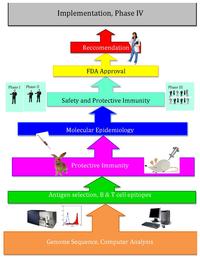
Photo from wikipedia
Ascariasis is the most prevalent helminthic disease affecting both humans and pigs and is caused by the roundworms Ascaris lumbricoides and Ascaris suum. While preventive chemotherapy continues to be the… Click to show full abstract
Ascariasis is the most prevalent helminthic disease affecting both humans and pigs and is caused by the roundworms Ascaris lumbricoides and Ascaris suum. While preventive chemotherapy continues to be the most common control method, recent reports of anthelminthic resistance highlight the need for development of a vaccine against ascariasis. The aim of this study was to use a reverse vaccinology approach to identify potential vaccine candidates for Ascaris. Three Ascaris proteomes predicted from whole-genome sequences were analysed. Candidate proteins were identified using open-access bioinformatic tools (e.g. Vacceed, VaxiJen, Bepipred 2.0) which test for different characteristics such as sub-cellular location, T-cell and B-cell molecular binding, antigenicity, allergenicity and phylogenetic relationship with other nematode proteins. From over 100,000 protein sequences analysed, four transmembrane proteins were predicted to be non-allergen antigens and potential vaccine candidates. The four proteins are a Piezo protein, two voltage-dependent calcium channels and a protocadherin-like protein, are all expressed in either the muscle or ovaries of both Ascaris species, and all contained high affinity epitopes for T-cells and B-cells. The use of a reverse vaccinology approach allowed the prediction of four new potential vaccination targets against ascariasis in humans and pigs. These targets can now be further tested in in vitro and in vivo assays to prove efficacy in both pigs and humans.
Journal Title: Frontiers in Veterinary Science
Year Published: 2022
Link to full text (if available)
Share on Social Media: Sign Up to like & get
recommendations!